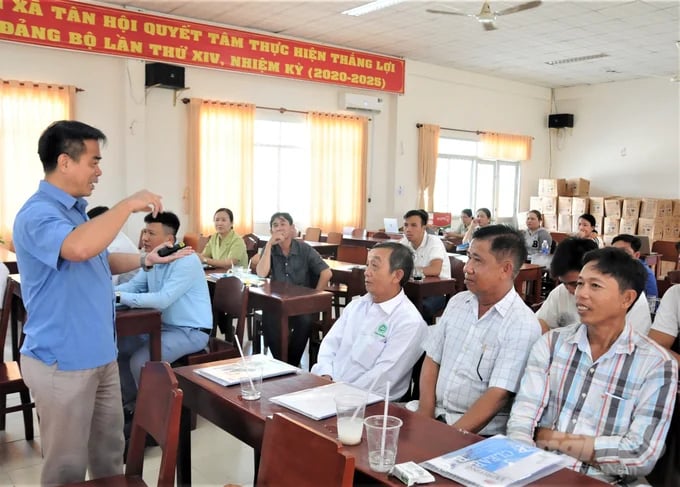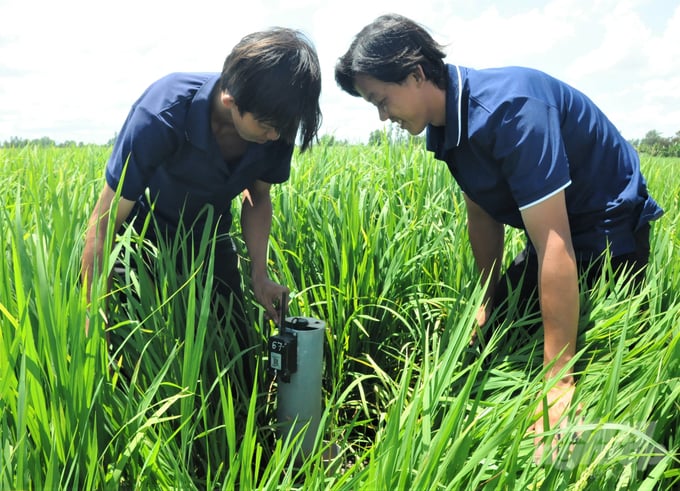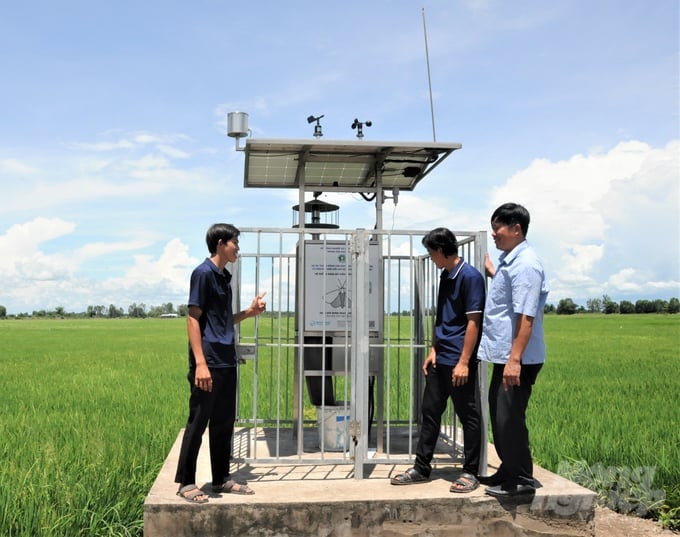June 20, 2025 | 11:49 GMT +7
June 20, 2025 | 11:49 GMT +7
Hotline: 0913.378.918
June 20, 2025 | 11:49 GMT +7
Hotline: 0913.378.918
On May 22 in Tan Hoi commune (Tan Hiep district, Kien Giang province), the National Agricultural Extension Center (Permanent Office in the Southern Region) in collaboration with the Kien Giang Agricultural Extension Center organized a training class on high-quality and low-emission rice production techniques in the Mekong Delta region. The training class aims to serve the development of pilot models under the Project for Sustainable Development of 1 Million Ha of High-Quality, Low-Emission Specialized Rice Linked to Green Growth in the Mekong Delta by 2030 (the 1 Million Ha Rice Project).

Experts shared knowledge on high-quality, low-emission rice production techniques, combining theory, discussion, and practice. Photo: Trung Chanh.
Nearly 30 trainees attended the training class, all members of the Thanh Nien Phu Hoa Agricultural Service Cooperative (Tan Hoi commune) – one of the farmer organizations in Kien Giang province selected for the pilot implementation of the 1 Million Ha Rice Project starting from the summer-autumn rice crop of 2024 with an area of 50 ha out of the cooperative's total area of over 600 ha.
During the two-day training (May 22-23), the trainees acquired knowledge about high-quality, low-emission rice production techniques in the Mekong Delta, provided by the Department of Crop Production, with the support of the International Rice Research Institute (IRRI) and several domestic experts.
The process covers all stages of rice production and includes three components: cultivation techniques, harvesting and post-harvest handling, and straw management. These components are interconnected and unified to form a complete, synchronized system for rice production within the 1 Million Ha Rice Project region.

Members of the Thanh Nien Phu Hoa Agricultural Service Cooperative exchange and discuss during the training session. Photo: Trung Chanh.
The trainees were provided with knowledge about high-quality, low-emission rice production techniques by the experts, combining theory, discussion, and practical application in the fields. The content was divided into specific topics and components to make it easier for the trainees to absorb.
The cultivation technique component includes techniques in soil preparation, water management, sowing, fertilization, and integrated pest management based on sustainable cultivation principles and emission reduction. The harvesting and post-harvest handling component includes techniques in harvesting, rice drying, and storage based on principles of improving rice quality, reducing post-harvest losses, and saving energy. The straw management component includes techniques for managing straw and stubble based on principles of recycling and emission reduction.
The high-quality, low-emission rice production techniques for the Mekong Delta region are trained for households, cooperatives, farms, and businesses. Cooperatives play a crucial role in implementation with the technical support of community agricultural extension officers. The process is applied in high-quality, low-emission specialized rice cultivation areas of the 1 Million Ha Rice Project and other regions with similar conditions.
Rice cultivation techniques include main steps such as soil preparation, sowing, water management, fertilization, and integrated pest management. Fields need to be levelled. Annually, the fields should be ploughed and left fallow during the dry season after harvesting the winter-spring rice crop. For the remaining crops, the methods of tilling, harrowing, and disking are applied.

The Phu Hoa Youth Agricultural Service Cooperative has been equipped with a greenhouse gas emission monitoring station for rice production, installed in the fields participating in the pilot implementation of the 1 Million Ha High-Quality, Low-Emission Rice Project. Photo: Trung Chanh.
Fertilize appropriately and balance according to the rice plant's needs, specific regions, and seasons. It is encouraged to use the leaf colour chart to adjust the amount of nitrogen fertilizer appropriately. When sowing rice combined with fertilizer incorporation, reduce the nitrogen amount by 10-15% compared to the method of sowing without fertilizer incorporation. Apply integrated pest management (IPM) based on the foundation of integrated plant health management (IPHM). Follow the 'four correct' principles in using plant protection chemicals, and prioritizing biological and herbal-based plant protection products.
Harvest the rice at the right time, when about 85-90% of the grains are ripe, using a combine harvester. Apply advanced drying and storage technologies to minimize post-harvest losses. Encourage the application of digital technology in managing and storing rice.
One of the important components of the 1 Million Ha Rice Project is the organization of production according to the rice value chain, linking producers and businesses at various stages of the rice production process to share and enhance the benefits for each participant in the value chain. Accordingly, the output of one business entity becomes the input for the next business entity in the business process.

Members of the Phu Hoa Youth Agricultural Services Cooperative check the automatic water level measurement sensor equipment in the rice fields participating in the pilot model of the 1 Million Ha High-Quality, Low-Emission Rice Project. Photo: Trung Chanh.
Organizing rice production linkage through contracts brings significant benefits. It focuses on gathering many small-scale farmers into a cohesive production area with uniform quality and concentrated quantity. This creates a two-way information connection between the consumer market and producers, ensuring that products meet market demands for quality standards and food safety, thereby increasing competitiveness and product value. It integrates processing industries and service businesses with the rural economy, playing a crucial role in diversifying and industrializing the rural economy and promoting the linkage between agriculture and industry.

The intelligent pest and insect management station helps the Phu Hoa Youth Agricultural Services Cooperative manage pests effectively, reduce costs, and protect the environment in rice production. Photo: Trung Chanh.
Farmer organizations (cooperatives) play a key role in implementing the 1 Million Hectares High-Quality, Low-Emission Rice Project. In participating in the rice value chain, cooperatives represent farmers in negotiating and signing contracts with enterprises; they oversee and support member farmers in following the production processes as per the contracts. They also serve as the primary point for receiving inputs from enterprises advanced to farmers for production, and they organize various services such as land preparation, sowing, irrigation, rice care (fertilizer application, pesticide spraying), harvesting, transportation, and drying.
Experts highlight four key factors for the success of the 1 Million Hectares Rice Project. First, the application and dissemination of high-quality, low-emission rice production processes. Second, the establishment of cooperatives participating in large-scale production and consumption linkages in the rice value chain. Third, the development of a Vietnamese high-quality rice brand that protects the environment and adapts to climate change. Fourth, a robust policy system for investment and support in the rice industry.
Translated by Hoang Duy
![Turning wind and rain into action: [9] Digitizing hydrometeorological data in response to climate change](https://t.ex-cdn.com/nongnghiepmoitruong.vn/608w/files/news/2025/06/17/z6704423696987_15fd32ffc26d590d204d520c9dac6786-nongnghiep-165943.jpg)
(VAN) Farmers have begun accessing hydrometeorological applications to adjust their cropping schedules, aiming to ensure productivity and adapt to climate change.
![Turning wind and rain into action: [8] Real-time salinity detection and early warning technology](https://t.ex-cdn.com/nongnghiepmoitruong.vn/608w/files/news/2025/06/17/z6704423696987_15fd32ffc26d590d204d520c9dac6786-nongnghiep-151127.jpg)
(VAN) Thanks to the integration of modern hydrological-hydraulic models, remote sensing technologies, and artificial intelligence, the accuracy of hydrological forecasting has significantly improved.
![Turning wind and rain into action: [7] Early disaster warnings help marine farmers minimize losses](https://t.ex-cdn.com/nongnghiepmoitruong.vn/608w/files/news/2025/06/17/z6704423696987_15fd32ffc26d590d204d520c9dac6786-nongnghiep-142942.jpg)
(VAN) In recent years, thanks to early disaster warnings and forecasting, marine farmers in Khanh Hoa province have been able to reduce risks and losses, thereby improving production efficiency.
![Turning wind and rain into action: [6] ‘Four on-the-spot’ disaster management software](https://t.ex-cdn.com/nongnghiepmoitruong.vn/608w/files/news/2025/06/17/e5a48259d6a262fc3bb3-nongnghiep-183800.jpg)
(VAN) By simply activating the scenario on the disaster management software, the relevant authorities immediately know how many households need to be evacuated, where to evacuate them to, and by what means of transportation…
![Turning wind and rain into action: [5] Hue applies modern technology in disaster forecasting](https://t.ex-cdn.com/nongnghiepmoitruong.vn/608w/files/news/2025/06/17/z6704423696987_15fd32ffc26d590d204d520c9dac6786-nongnghiep-093938.jpg)
(VAN) In Hue city, modern technology has recently been applied in meteorological and hydrological forecasting and warning, helping to reduce the damage caused by natural disasters.

(VAN) A cutting-edge farming technique being implemented on an experimental ranch in Arizona's Sonoran Desert has already saved a billion gallons of water over five years, according to Civil Eats.

(VAN) Poultry and pig production and the environment can be boosted through enhanced water technology, according to new research.